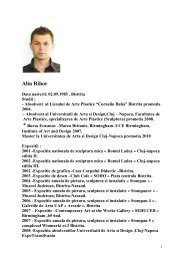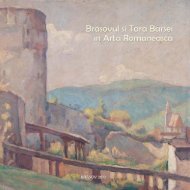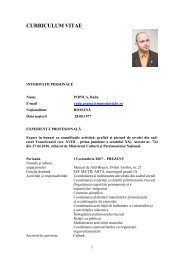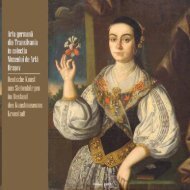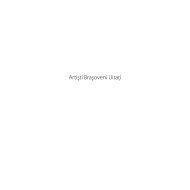Catalog Hans Eder PDF - Muzeul de Arta Brasov
Catalog Hans Eder PDF - Muzeul de Arta Brasov
Catalog Hans Eder PDF - Muzeul de Arta Brasov
Erfolgreiche ePaper selbst erstellen
Machen Sie aus Ihren PDF Publikationen ein blätterbares Flipbook mit unserer einzigartigen Google optimierten e-Paper Software.
proiectată pe fundalul unui grandios<br />
peisaj alpin, în <strong>de</strong>corul unui tipic<br />
sat transilvan, compoziţia exploatează<br />
contrastul dintre o aparentă seninătate<br />
şi o sfâşietoare tensiune lăuntrică.<br />
Sublimul naturii, atmosfera tihnită,<br />
chiar patriarhală, firescul activităţilor<br />
cotidiene, investite cu conotaţii simbolice<br />
(naşterea, viaţa, moartea) în<br />
tradiţia picturii flaman<strong>de</strong> (Brueghel),<br />
sunt contrapuse cu elemente disonante.<br />
isus, pradă suferinţei, „se zvârcoleşte<br />
<strong>de</strong> parcă ar voi să fugă <strong>de</strong> pe cruce”<br />
încât „crezi că asişti la însuşi actul<br />
răstignirii” 16 . Figura sa pare <strong>de</strong>sprinsă<br />
din pictura lui Grünewald 17 . Se adaugă<br />
<strong>de</strong>znă<strong>de</strong>j<strong>de</strong>a bărbatului aflat la baza<br />
crucii 18 , singurul conştient <strong>de</strong> suferinţa<br />
Răstignitului. Doi ani mai târziu, <strong>E<strong>de</strong>r</strong> a<br />
reluat compoziţia într-o manieră asemănătoare<br />
19 fără să obţină o forţă sugestivă<br />
similară.<br />
Seria Răstignirilor se încheie în 1930<br />
cu o lucrare 20 singularizată printr-un<br />
cadru şi o expresie stilistică aparte.<br />
Scena este plasată într-un peisaj solar,<br />
mediteranean, amintind <strong>de</strong> peisajele<br />
pictate <strong>de</strong> <strong>E<strong>de</strong>r</strong> în sudul Franţei, atât<br />
prin configuraţia spaţială, cât şi prin<br />
cromatica arzătoare şi pensulaţia exuberantă,<br />
<strong>de</strong> o spontaneitate extremă.<br />
Liniile sinuoase din partea inferioară a<br />
compoziţiei sunt contrapuse verticalităţii<br />
crucilor şi peisajului stâncos, generând<br />
o intensă dinamică radiantă. Doar<br />
silueta statuară a femeii din prim-plan,<br />
încremenită în tristeţe, părând <strong>de</strong>sprinsă<br />
dintr-o altă lume, se sustrage mişcării<br />
generale.<br />
Evoluţia schiţată mai sus, apropierea<br />
<strong>de</strong> Noua obiectivitate, este indicată şi<br />
geruhsame, sogar patriarchalische<br />
Atmosphäre, die Selbstverständlichkeit<br />
alltäglicher verrichtungen, die in<br />
<strong>de</strong>r tradition <strong>de</strong>r flämischen Malerei<br />
(Brueghel) mit symbolischen Konnotationen<br />
versehen wer<strong>de</strong>n (Geburt,<br />
Leben, tod), wer<strong>de</strong>n im Gegensatz zu<br />
dissonanten Elementen dargestellt.<br />
Jesus, vom Schmerz zerrissen, „win<strong>de</strong>t<br />
sich, als wolle er vom Kreuze fliehen”<br />
so dass man „glaubt, zeuge <strong>de</strong>r eigentlichen<br />
Kreuzigung zu sein” 16 . Seine<br />
Gestalt scheint einem Bild von Grünewald<br />
17 entnommen. Dazu kommt<br />
die verzweiflung <strong>de</strong>s Mannes unter<br />
<strong>de</strong>m Kreuz 18 , <strong>de</strong>r Einzige, <strong>de</strong>r sich <strong>de</strong>s<br />
Lei<strong>de</strong>ns <strong>de</strong>s Gekreuzigten bewusst ist.<br />
zwei Jahre später nimmt <strong>E<strong>de</strong>r</strong> diesen<br />
Bildaufbau in ähnlicher Manier wie<strong>de</strong>r<br />
auf 19 , ohne die gleiche suggestive<br />
Kraft zu erreichen.<br />
Auf die oben ange<strong>de</strong>utete Entwicklung,<br />
die Annäherung an die Neue<br />
Sachlichkeit, <strong>de</strong>utet auch die Aufnahme<br />
eines neuen biblischen themas<br />
hin, Die Hochzeit zu Kana. Gera<strong>de</strong> die<br />
Wahl dieses Sujets zeigt eine Wandlung,<br />
nicht nur im Stilistischen, son<strong>de</strong>rn<br />
auch im Gefühlsmäßigen, an.<br />
Das thema ordnet sich im vergleich<br />
zu <strong>de</strong>n im vorfeld besprochenen religiösen<br />
themen einem radikal an<strong>de</strong>rsartigen<br />
Bereich ein. Aus theologischer<br />
perspektive be<strong>de</strong>utet die Hochzeit zu<br />
Kana, wie sie im Johannesevangelium<br />
erzählt wird, das zeichen <strong>de</strong>s neuen<br />
Bun<strong>de</strong>s zwischen Gott und <strong>de</strong>n Menschen,<br />
das Kommen <strong>de</strong>s Wortes Gottes<br />
in die Welt, <strong>de</strong>r Anfang <strong>de</strong>r verkündigung<br />
Jesu, ein Grund zu Freu<strong>de</strong> und<br />
Hoffnung 20 .<br />
towards the New objectivity. the<br />
transformation appears not only in<br />
the stylistic expression, but also in the<br />
emotional tonality. the theme differs<br />
radically from those we have already<br />
analysed. From a theological perspective,<br />
the cana miracle, as contained<br />
in the Gospel of John, represents the<br />
new Alliance between God and man,<br />
a strong manifestation of the Divine<br />
Logos which fills the world, the beginning<br />
of Jesus’ public ministry, reason<br />
for joy and hope 21 .<br />
Similar both in composition and in<br />
style, both variants 22 are structured<br />
round the central figure of Jesus with<br />
the witnesses to the miracle distributed<br />
on either of the si<strong>de</strong>s. Significant<br />
differences appear only in the<br />
background of the scene. in the variant<br />
belonging to the Black church, <strong>E<strong>de</strong>r</strong><br />
resorts to the common contemporary<br />
background. in the one from the Evangelical<br />
church in Sibiu, the scene takes<br />
place in a lush, exuberant scenery reminding<br />
of the Gar<strong>de</strong>n of paradise.<br />
the works capture the miraculous moment<br />
when water turns to wine. our<br />
attention is immediately drawn to the<br />
table placed in front of Jesus, which<br />
offers <strong>E<strong>de</strong>r</strong> the opportunity to reconstruct<br />
a still-life of Flemmish inspiration.<br />
From the jars filled with water a<br />
bright light radiates. Blaga noted that<br />
“<strong>E<strong>de</strong>r</strong> expands to its utmost the circle<br />
of won<strong>de</strong>r…” which embraces with its<br />
miraculous light the audience as well<br />
as the lifeless elements, ascertaining<br />
that “the proposal of this miracle<br />
springs from the ensemble of the elements<br />
<strong>de</strong>picted, from the festal lines



